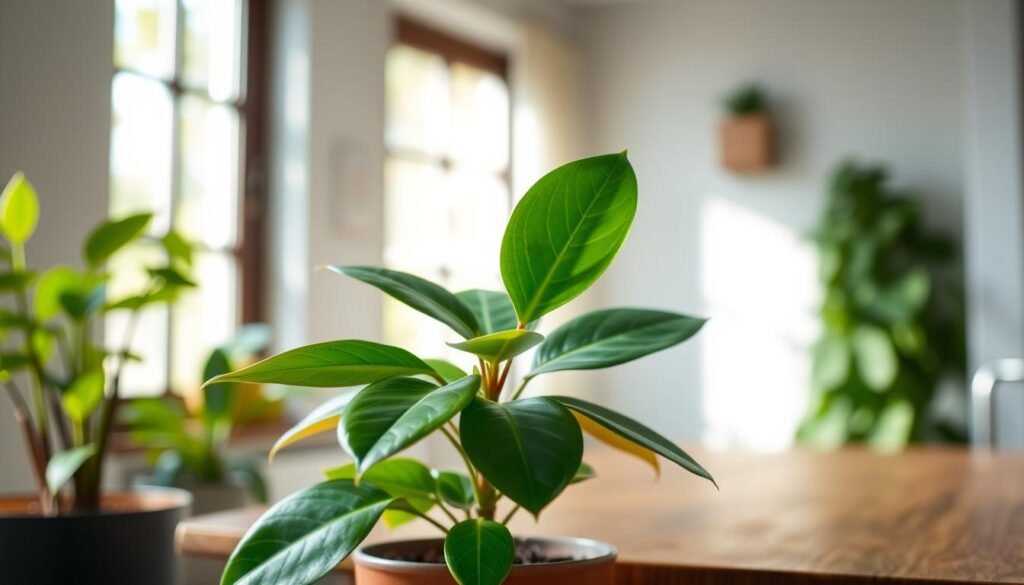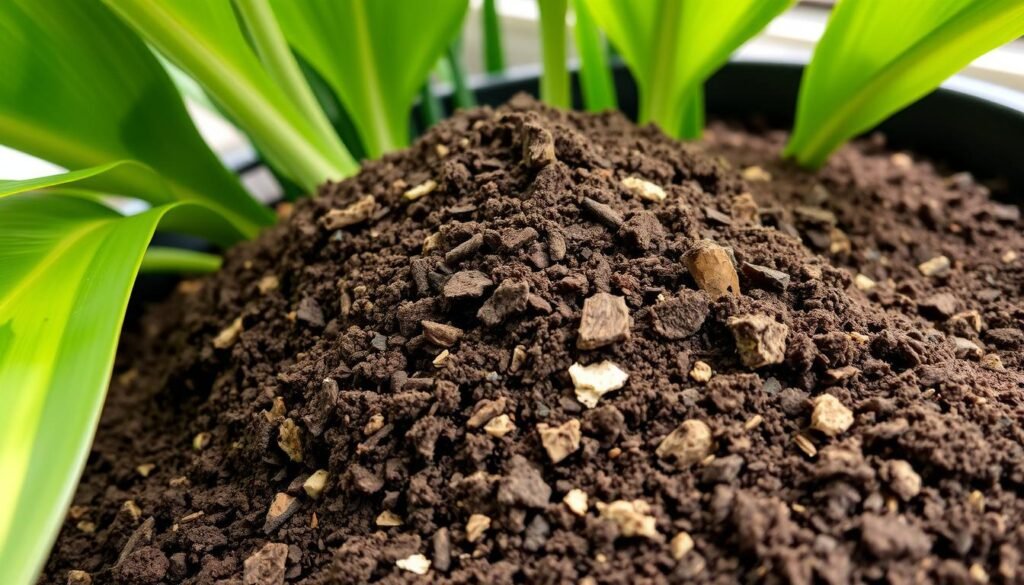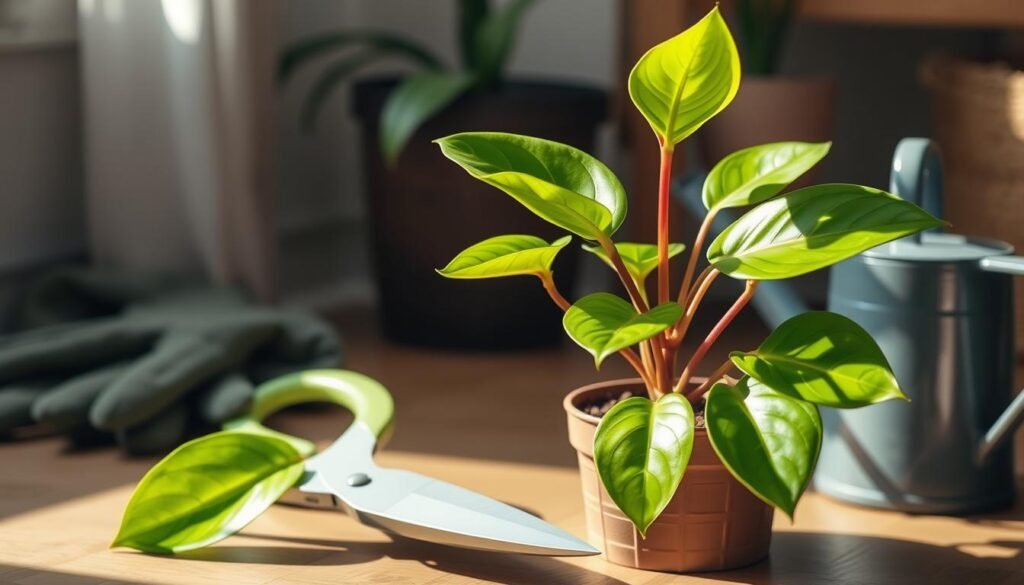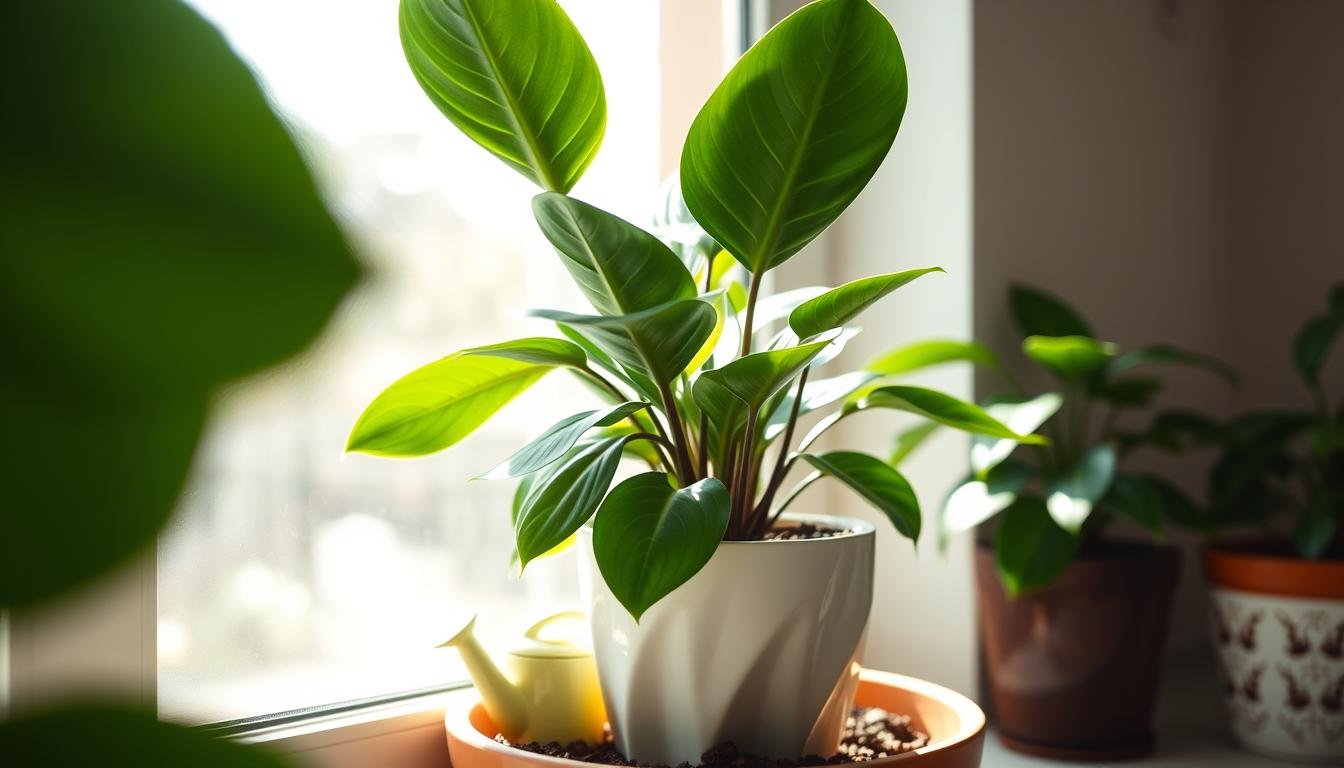The Baby Rubber Plant, also known as Peperomia obtusifolia, is a great choice for those who want easy-to-care-for houseplants. It has beautiful leaves and grows up to 20 inches tall. It can live indoors for 5-6 years, adding beauty to any room. To keep your Baby Rubber Plant healthy, it’s important to know about its light needs and how to care for it properly.
In this guide, you’ll learn how to take good care of your Baby Rubber Plant. We’ll cover watering, soil, and pruning tips. With these tips, you can make sure your plant grows well.
Table of Contents
Introduction to Baby Rubber Plants
The baby rubber plant, known as Peperomia obtusifolia, is loved for its beauty and simple care. It comes from the West Indies, South America, and Mexico. Its thick leaves can hold water, perfect for both new and seasoned plant lovers.
Also called the Pepper Face Plant or American Baby Rubber Plant, it has shiny leaves up to 10 cm long. Some have cool patterns. It grows to about 20 inches tall, adding green without taking over.
This plant is part of the Peperomia family, with over 1,000 species. In 2022, the National Garden Bureau named it the Year of the Peperomia. It’s easy to care for and can grow well in different conditions.
It needs water every 1-2 weeks, letting the soil dry in between. It’s also safe for pets and resistant to pests. This makes it a great choice for homes with animals.

Caring for the baby rubber plant is rewarding. It prefers warm, humid places and doesn’t like frost or cold air. By having a Peperomia obtusifolia at home, you get a beautiful and hardy friend.
Understanding Rubber Plant Light Requirements
The Baby Rubber Plant, also known as Peperomia obtusifolia, comes from South America. It thrives indoors with the right light. It needs bright, indirect sunlight for at least six to eight hours daily.
Baby Rubber Plants can handle low light but may not grow well. If your plant looks leggy, has dull leaves, or grows slowly, it might need more light. A spot near east or west-facing windows is perfect. Direct sunlight can burn the leaves and change their color.
Variegated rubber plants need more light to keep their colors bright. Watching how much light your plant gets is important. If the leaves start to look stressed, move your plant to a better spot. With the right light, your rubber plant will be a beautiful addition to your home.
| Light Quality | Effect on Growth |
|---|---|
| Bright, Indirect Sunlight | Optimal growth, lush foliage |
| Medium/Artificial Light | Slower growth, possible leggy appearance |
| Low Light | Dull leaves, reduced health |
| Direct Sunlight | Leaf scorch, discoloration, drooping leaves |
Baby Rubber Plant Care: Watering Needs
Knowing how to water your Baby Rubber Plant is key to keeping it healthy. This plant does best when you watch the soil moisture closely. Adjust how often you water based on the soil’s moisture. This helps prevent root rot.
Identifying Soil Moisture Levels
Start by checking the top two inches of soil. Wait until this layer is dry before watering again. If it’s dry, your plant needs water. But, if it’s damp, wait longer to avoid root damage.
Watering Frequency Guidelines
Baby Rubber Plants usually need water every 7-10 days when it’s warm. In the cooler winter months, you can wait up to 14-18 days. Sticking to these times helps your plant stay healthy.
| Condition | Watering Frequency | Soil Moisture Status |
|---|---|---|
| Growing Season | Every 7-10 days | Top 2 inches dry |
| Winter | Every 14-18 days | Top 2 inches dry |
| Overwatering Signs | – | Yellowing leaves, mushy stems |
| Underwatering Signs | – | Wrinkled foliage |

Choosing the Right Rubber Plant Soil Mix
Choosing the right soil mix is key for a healthy Baby Rubber Plant. It helps your plant grow well in a balanced environment. The mix supports root growth and keeps moisture without letting water pool.
Importance of Well-Draining Soil
Well-draining soil stops root rot, a big problem for Baby Rubber Plants. A good mix includes aeration and moisture retention. Aim for 3 parts potting mix, 1 part perlite, and 1 part orchid bark blend. This keeps the pH between 6 and 6.6, perfect for your plant.
Recommended Soil Amendments
Adding soil amendments can make your mix better. Use high nitrogen fertilizer every four weeks to feed your plant. Young plants need high phosphorus. Adjusting pH with lime or sulfur helps growth. But watch out for too much salt and compacted soil.

| Soil Component | Proportion | Purpose |
|---|---|---|
| Potting Mix | 3 parts | Base structure for nutrients |
| Perlite | 1 part | Increases aeration |
| Orchid Bark Blend | 1 part | Promotes drainage |
| Compost | 1 part (for DIY mix) | Enhances nutrient content |
Using the right soil mix boosts your Baby Rubber Plant’s growth. Refresh the soil often and check moisture levels. This keeps your plant healthy and looking great.
Effective Rubber Plant Pruning Tips
Learning the right ways to prune your Baby Rubber Plant can lead to healthy growth and a vibrant look. The right pruning tips can greatly help in managing the plant’s size and shape. With the right timing and technique, you can get the best results.
When to Prune Your Rubber Plant
The best time to prune your rubber plant is in the growing seasons, spring and summer. This lets the plant grow back quickly. Pruning in winter is okay, but cut less because the plant is dormant.
Watch for signs like leggy stems or yellow leaves. These signs mean it’s time to prune.
Techniques for Healthy Growth
Using the right pruning techniques helps your Baby Rubber Plant grow better and look great. Here are some key methods:
- Always prune just above the nodes on the trunk to stimulate side shoots and maintain a bushier appearance.
- Remove any dead or damaged leaves promptly to prevent disease spread.
- Use clean, sharp pruning tools to avoid damaging the plant and introducing infections.
- Limit the amount of foliage removed to about one-quarter of the plant’s size to prevent stress.
After pruning, it’s important to care for your plant well. Make sure it gets enough water and light. With these tips and techniques, your Baby Rubber Plant will flourish, showing off lush, vibrant leaves.

| Pruning Timing | Best Practices | Common Mistakes |
|---|---|---|
| Spring/Summer | Use sharp tools, prune above nodes | Over-pruning, removing too much foliage |
| Winter | Limit cuts to minor adjustments | Failure to care for wounds, neglecting post-pruning care |
Addressing Common Rubber Plant Leaf Problems
It’s important to spot and fix rubber plant leaf issues to keep your Baby Rubber Plant healthy. You might see yellow leaves, curling, or brown tips. These signs can mean your plant is stressed and need your help.
Recognizing Symptoms of Stress
Stress in plants can show up as yellow leaves, curling, or brown tips. Too much water can cause root rot, which is bad for your plant. Yellow leaves and soft stems often mean your plant has too much water.
Brown tips can mean your plant is thirsty or cold. Not getting enough nutrients can also stress your plant. Yellow veins might mean a lack of magnesium, while pale leaves could mean iron.
Treating Common Leaf Issues
To fix leaf problems, start by removing damaged leaves. Make sure the soil isn’t too wet before watering again. If your pot doesn’t have holes, use less water.
Check for pests like spider mites and mealybugs often. These bugs can harm your plant. If you find pests, use insecticidal soap to fight them off.
Keeping your rubber plant happy also means watching the environment. They like bright, indirect light and stable temperatures. Avoid extreme temperatures and humidity to help your plant grow well.
| Leaf Issue | Symptoms | Treatment |
|---|---|---|
| Yellowing Leaves | Soft stems, possible root rot | Reduce watering, ensure drainage |
| Browning Tips | Crispy edges, possible underwatering | Adjust watering frequency, maintain humidity |
| Fungal Infections | Mold on soil or leaves | Improve ventilation, use fungicides if necessary |
| Pest Infestation | Visible pests, leaf damage | Apply insecticidal soap, regular inspections |
| Nutrient Deficiencies | Discoloration, weak growth | Fertilize appropriately, consider soil amendments |
Rubber Plant Repotting Guide
Repotting your Baby Rubber Plant is key for its health. Knowing when and how to do it boosts its growth. Watch for signs to know when it’s time for repotting.
Signs It’s Time to Repot
Look out for these signs:
- Stagnant growth despite proper care.
- Roots emerging from the drainage holes.
- Roots tightly bound within the pot.
Acting on these signs quickly is vital for your plant’s health.
Best Practices for Repotting
This guide stresses the importance of timing and materials. Spring is the best time to repot, matching the plant’s growth cycle. Here are some tips:
- Choose terracotta, ceramic, or plastic pots. Terracotta is great for humid areas, ceramic balances moisture and drainage, and plastic is light and affordable.
- Steer clear of glass pots to avoid root rot.
- Opt for a pot only 3cm larger than the current one. This size allows for growth without water retention issues.
- Water the plant with room-temperature water after repotting. Place it in bright, indirect sunlight for recovery.
- Wait a few weeks before fertilizing to let the plant settle.
Rubber Plant Propagation Methods
Rubber plants, like the Baby Rubber Plant, are easy to grow more of. You can use stem cutting or leaf propagation to do this. Each method has its own benefits, making it easy to find the right one for you.
Stem Cutting Technique
The stem cutting method is popular because it’s simple and works well. Start by picking a healthy stem that’s 4 to 6 inches long. Make sure it has at least three leaves for the best growth.
Then, cut just below a node, where roots will grow. You can put the cutting in water or soil. In water, keep the node submerged and watch for roots in a week or two. In soil, keep it moist and wait a couple of months for roots.
If you’re using water, change it every two to three weeks to prevent bacteria.
Leaf Propagation Basics
Leaf propagation is another way to grow new Baby Rubber Plants. Take a healthy leaf and a bit of its stem. Plant it in moist soil, covering it lightly to keep it humid.
Place it in indirect light to help it root. Leaf propagation takes time, but it’s worth it. Both stem cutting and leaf propagation work well, but do best in warmer months.
Conclusion
Caring for your Baby Rubber Plant is rewarding and can make your indoor space more beautiful. Knowing the basics of baby rubber plant care is key. This includes understanding light, water, and soil needs.
These plants love bright, indirect light and prefer humidity of 40%-50%. This keeps their leaves looking vibrant and healthy.
Regular indoor plant care is important. Water only when the soil is dry, and fertilize three times a year. Pruning at the right time can also help your plant look its best.
By following these simple steps, you can grow a thriving Peperomia. It will not only add greenery but also make your home feel welcoming.
With the right knowledge and patience, caring for your Baby Rubber Plant is a joy. It’s a great choice for beginners and can live 5-6 years indoors with proper care. Enjoy the journey of plant care and the rewards it brings.



